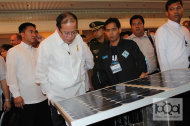A Moro Filipino shines at West Point
By Benjamin Pimentel
Philippine Daily Inquirer
Saturday, June 11th, 2011

Uzi Ibrahim, Filipino American, Moro, Filipino, Philippines, United States, history, war, US, West Point
A hundred years ago, Uzi Ibrahim’s forefathers were fighting for their lives, defending Mindanao against invading US forces led by Gen. John J. Pershing. Last month, Uzi, who was born in Mindanao, marched as a member of the graduating Class of 2011 of West Point, the military academy where Pershing trained to be a soldier and where he is still highly regarded as a distinguished alum.
Uzi even won an award named after Pershing.
“I was both in disbelief and hopeful,” he told me on receiving the honor given to graduating cadets.
“If a hundred years later the descendant of one of America’s fiercest opponents could enter the same halls as General Pershing to become a leader,” he added, “it gives me hope that a lot of things can change in the world.”
Unique odyssey
In 21-year-old Uzi Ibrahim, we find a unique odyssey.
It is a journey of a young man who proudly considers himself a Moro Filipino. He is a child of Sept. 11, who is eager to serve as a soldier of the United States, but also looking to give back to the country, to the island where his people fought bravely for their freedom a century ago.
In many ways, his story and his beliefs underscore the complexities of the US and the world after Sept. 11, which reached another turning point with the killing of Osama bin Laden.
Some may disagree with Uzi’s views. But he tells his story with sincerity and quiet conviction.
Pride and prejudice
Uzi was three years old when his family moved to the United States. He was 11 when terrorists hijacked the planes that slammed against the Twin Towers in New York on Sept. 11, 2001, killing nearly 3,000 people.
Two days after the attacks, he felt the sting of the tragedy. In a moment that he still recalls vividly, a close of friend of his yelled out in class, “I hate Muslims!”
“I was completely blown away by this, and very upset to the point that I left the classroom in tears,” he told me. “I remember that I went through a time of self-searching and I was wondering what I did wrong.”
But the outburst led to a teaching moment for him and his friend who later came up to him and apologized.
“The thing was that he never even knew that I was a Muslim, or really understood what being a Muslim was all about. It was then I realized that, it wasn’t them but it was my fault that events had led up to that point. I think this was a very defining moment in my life.”
Uzi moved on. Though prejudice against Muslims intensified in the US after Sept. 11, he says his identity has “never been an issue.”
Youth leadership
He became class president of his high school in West Virginia, a state known for its conservatism. He even became governor of Boy’s State, the West Virginia leadership academy.
“What this shows is you can dwell on the differences all you want,” he told me. “But at the end of the day is it making the situation any better? Am I being a wall or am I being a bridge?”
His parents—his father is Muslim, his mother, Catholic—stressed two important lessons, he said: “To be tolerant of other people and to fight for what you believe in.”
Moros don’t quit
With those values and an intensifying interest in leadership, Uzi set out for West Point.
It wasn’t easy.
His father, Oscar Ibrahim, recalled how there were times when the thought of quitting entered his son’s mind. Oscar encouraged him to keep going, joking with his son, “Well, where’s your Moro blood if you quit?”
At West Point, father and son even saw reminders of their forefathers’ struggles against the Americans. On display at the academy were weapons recovered from the Mindanao campaign, the US military’s first major war against a Muslim foe.
The kris and the Colt .45
Uzi remembers one particular item on display—a Moro sword of war, called kris.
“Time heals a lot of things and my reaction that day wasn’t anger or frustration, but amazement and a sense of pride. To me, the sword was a symbol of the fighting spirit of the Moro people, and the presentation of the sword was also a symbol of American respect for their adversary.”
That respect was even underscored in one of his classes on the history of the US military. It was during the Moro campaign that the Colt .45 was made standard issue for American troops. The reason: US forces needed more firepower to stop the Moro fighters.
It’s a fact Uzi reflects on with pride. “I come from a tough bunch of people, something that I have a lot of pride in. I mean, the Colt .45 is a really powerful weapon, and the fact that Moro warriors could take .38 cal. bullets and still have the determination and willpower to take down their enemy is nothing short of amazing. Ultimately, when I’m going through hard times, I like to reflect on stories such as this as it inspires me to attack problems or issues with the same amount of spirit, [to believe] that I can take pain and I can keep going.”
Remembering Mount Dajo
In fact, the war that the US waged in Mindanao and the rest of the Philippines was hardly an honorable campaign. There were atrocities. No less than Mark Twain, the great American writer, spoke out against one of the most vicious abuses, the mass killing of hundreds of Moros trapped in a crater on Mount Dajo in Jolo in 1906.
“The enemy numbered six hundred,” Twain wrote, “including women and children-and we abolished them utterly, leaving not even a baby alive to cry for its dead mother… Our uniformed assassins had not upheld the honor of the American flag… They had dishonored it.”
But Uzi said these should be viewed in its historical context. “It was a hundred years ago. It should be judged in that respect. The Americans back then had a very different world view, had very different assumptions and beliefs.”
Moving on
Despite the challenges of his early years at West Point, Uzi pushed on.
He studied engineering, majored in East Asian studies, and even became president of the West Point Asian Pacific Awareness Club. He learned Mandarin, adding to his knowledge of Spanish and Cebuano.
As in the past, he said, his Muslim identity never became an issue at West Point.
“It never was. People have bent over backward to help me out. There is a chapel here for Muslim services. People are very professional around here. I’m very proud of this organization.”
A military career awaits him after West Point. But Uzi is also considering other long-term plans that may not involve a military career. A recent visit to this family’s home province of Lanao made him more aware of the poverty in that part of the Philippines.
An officer and a scholar
His own scholarly work on the histories of other Asian countries has made him interested in development issues, specifically the question: How do poor nations eventually get out of poverty?
It’s a personal question, in many ways. For he has seen his own family back in Lanao struggling.
“You see the family in poor conditions and it makes you think: Why do you have to go to another country to send money back when you shouldn’t have to do that if the problems don’t exist?”
The road ahead
He has no set roadmap right now, he says. But whatever path he eventually takes, he knows his West Point training in leadership will come in handy when he does return to Mindanao.
“It’s a skill that I can take with me anywhere, that I can apply to any situation to make it better.”
He is aware that the situation in the Philippines, and in Mindanao in particular, is complex. And the reality of the Philippines is not even clear to some Filipino Americans.
He has even met Filipino Americans who were surprised to learn that there are Muslims in the Philippines.
With amusement he recalls being asked by FilAms, who apparently found it hard to imagine a non-pork-eating Filipino: “You’re Filipino, but you don’t eat lechon?”
 MANILA, Philippines (UPDATED) -- Filipino boxing superstar and reigning pound-for-pound king Manny Pacquiao is the second highest earning non-American athlete in the world.
MANILA, Philippines (UPDATED) -- Filipino boxing superstar and reigning pound-for-pound king Manny Pacquiao is the second highest earning non-American athlete in the world.


























